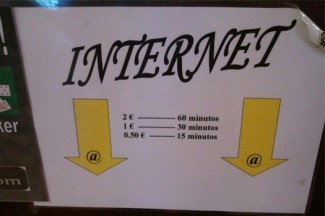
I saw the now-familiar log book on the coffee table. At each day’s destination, we turn over our Pilgrim Credential, which lists our name, starting point, hometown, and country of origin. All of this information is entered into the book, our Credential is stamped, and we are shown to our bed for the night. But Tosantos was different. Dani didn’t make any moves for the book. Instead he asked us about ourselves, where we were from, and our Camino experience thus far. It was refreshing to not be just another pilgrim to be entered into the log.
Twenty minutes later, I discovered why Dani delayed. “Before you decide to stay here, I need to tell you about one rule that we have. You can’t get up before 6:30.” Philipp and I let out big sighs of relief and heartily agreed that this was not a problem at all. Phillip was woken at 5 that very morning by pilgrims rustling in their bags eager to get the day started. “This is not a race,” Dani said. “We want you to enjoy the experience and get your rest.”

Perhaps some people would want to escape from technology while spending 40 days walking the Camino. I’m not one of them. I’m not addicted to my PDA, but I don’t see any need to leave the world of e-mails and Facebook entirely. Also, as a single woman traveling alone in a foreign country, technology gives me a way to keep in touch with my family at home quickly, easily, and cheaply.
When St. Francis walked the Camino he didn’t have the ability to be as “connected” with the outside world as I have. He couldn’t post pictures and updates on Facebook. Nor was he able to post his thoughts to a blog in real time for the world to see. But he probably did write his thoughts, just as I do each day. He walked the same path and probably felt some of the same things I’ve felt along The Way — excitement, love, fear, disappointment, amazement, joy. Did he meet as many people from as many countries as I have? If he did, he surely didn’t collect their e-mail addresses.
So though I walk the same path as St. Francis, technology has certainly made our experiences different. I was asked, before I left, if I thought blogging from the Camino might take away from my experience. I never felt it would. I am a writer and a recorder of stories. I wanted to be able to do that while on this journey, and blogging for Busted Halo has given me a chance to not only document my journey, but to share it with others who may or may not do this journey themselves one day.
That being said, the logistics of being “connected” while walking through towns of a mere 20 people can sometimes be a little daunting. I never considered carrying a laptop. I don’t own one light enough to justify its weight in my pack (though I met three people carrying iPads in theirs). I knew that I would walk through at least four major cities on this journey (Pamplona, Burgos, Leon and Santiago), so figured accessing the Internet in order to send my posts would be possible then.
It certainly hasn’t always been easy. There have been times when, for three consecutive days, I haven’t been able to find a computer on which to write these posts. Or I’d get to a place with a computer only to find it’s not working that day. Or I’d find a Wi-Fi connection, but it wouldn’t allow me to upload my photos. St. Francis had none of these problems.
But to me, it’s all worth it. Not only am I able to share my journey and experiences, but through writing these posts I’ve received a most unexpected — and welcome — gift: comments. I was delighted the first time I logged in from the Camino to see that six people had responded to my first post offering encouraging words — and four of those people I’d never even met. One couple wrote to send prayers and luck and to tell me their young adult group was following my journey. Really? There were people out there awaiting my next post? A whole group of them? It made my search for a computer all the more worthwhile.
Comments people wrote in response to my posts brought me great joy, motivated me, and moved me to tears sometimes. I wonder: if St. Francis was walking this path today, would he choose to use technology to communicate his thoughts on this journey? He had a message he wanted to share. I think he might have used any means he could. And blogging would make it a two-way street: he could share his message and his “followers” could respond, ask further questions, offer support and encouragement — just as mine were able to do for me during my journey.
___________________________________________
What encouraging words could you offer today? Via the Internet or in person, take a moment to send a message to someone.